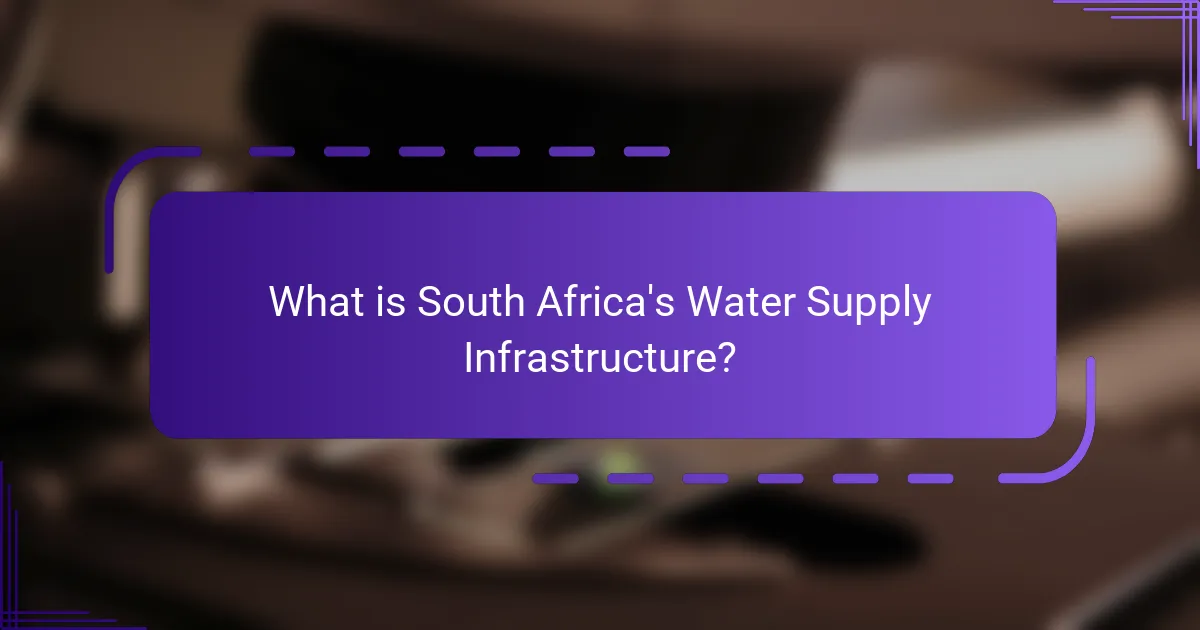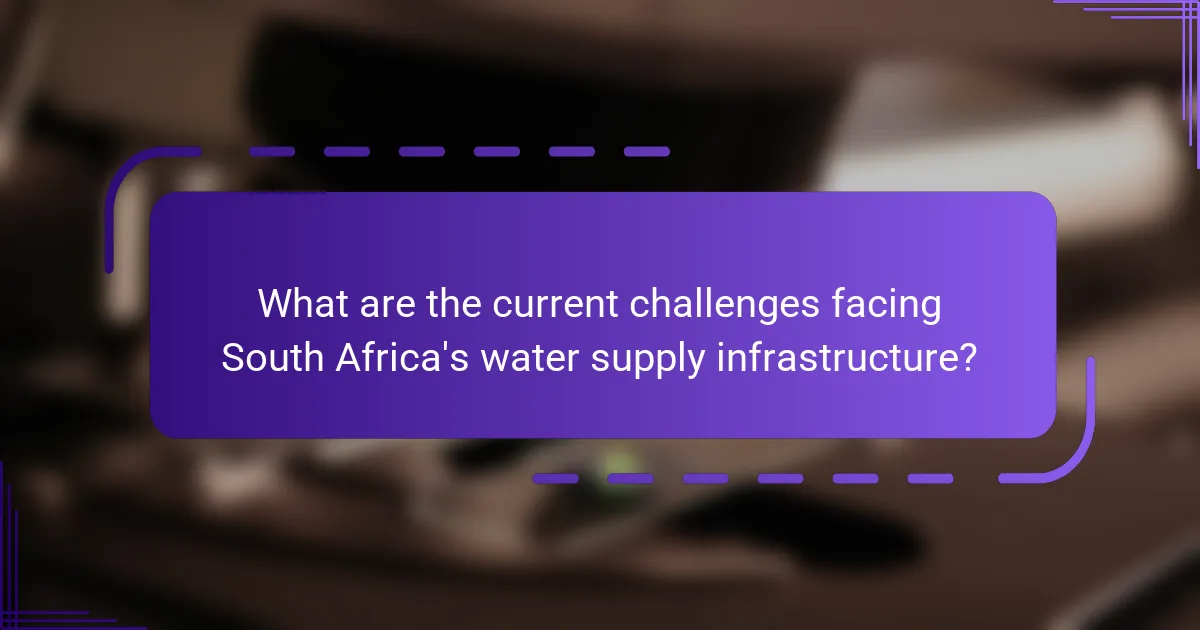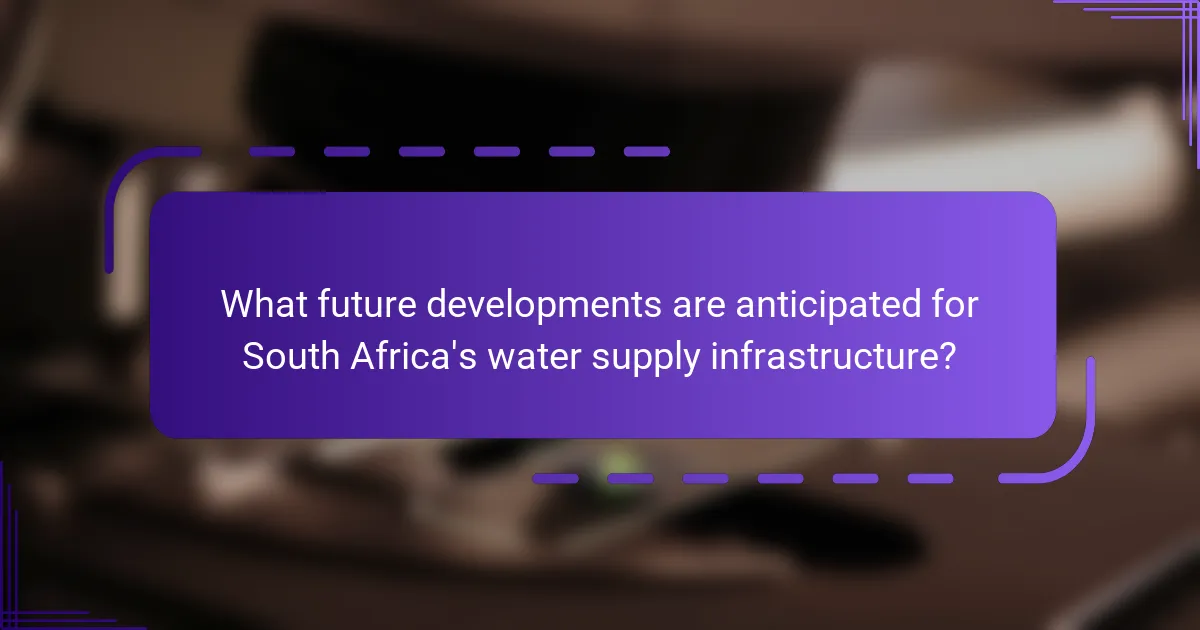South Africa’s water supply infrastructure encompasses a complex network of dams, pipelines, and treatment plants designed to manage and distribute water across both urban and rural areas. Key components include major storage facilities like the Katse and Gariep Dams, along with regional systems such as the Lesotho Highlands Water Project. The infrastructure faces significant challenges, including aging systems, water scarcity due to drought, pollution, and inequitable access, particularly affecting marginalized communities. Future developments aim to address these issues through increased investment in desalination, upgrades to aging pipelines, modernization of wastewater treatment, and the implementation of smart water management systems, as outlined in the National Water and Sanitation Master Plan.

What is South Africa’s Water Supply Infrastructure?
South Africa’s water supply infrastructure consists of a network of dams, pipelines, and treatment plants. This system is designed to manage and distribute water across urban and rural areas. Major dams, such as the Katse and Gariep Dams, play a crucial role in water storage. The infrastructure also includes regional water supply systems, like the Lesotho Highlands Water Project. Water treatment facilities ensure the safety of drinking water. The country faces challenges like aging infrastructure and water scarcity. These issues impact the reliability of the water supply. Investment in upgrades and maintenance is essential for sustainability.
How is the water supply infrastructure structured in South Africa?
The water supply infrastructure in South Africa consists of a complex network of systems. This network includes dams, pipelines, treatment facilities, and distribution systems. Major water sources include rivers, groundwater, and reservoirs. The country relies on both surface water and groundwater supplies. Municipalities manage local water distribution. The Department of Water and Sanitation oversees national water resource management. Water quality is regulated to ensure safety for consumption. Challenges include aging infrastructure and water scarcity. According to the National Water Resource Strategy, efficient management is critical for sustainability.
What are the key components of the water supply system?
The key components of the water supply system include water sources, treatment facilities, distribution networks, and storage systems. Water sources consist of rivers, lakes, groundwater, and reservoirs. Treatment facilities purify water to meet safety standards. Distribution networks transport treated water to consumers through pipes. Storage systems hold water for supply during peak demand or emergencies. Each component is essential for ensuring reliable access to clean water.
How do these components interact to provide water services?
Water services are provided through the interaction of infrastructure, management systems, and community engagement. Infrastructure includes treatment plants, pipelines, and storage facilities that transport and purify water. Management systems oversee the operation and maintenance of these infrastructures, ensuring efficient delivery. Community engagement involves educating residents about water conservation and usage. These components work together to ensure that clean water reaches households. For instance, treatment plants convert raw water into potable water, while pipelines distribute it across regions. Effective management minimizes leaks and inefficiencies, enhancing service reliability. Community involvement fosters responsible water use, supporting sustainability efforts. Together, these elements create a comprehensive water service network.
Why is water supply infrastructure critical for South Africa?
Water supply infrastructure is critical for South Africa due to its role in ensuring access to clean water. This infrastructure supports agriculture, industry, and human consumption. South Africa faces water scarcity challenges, with only 9% of its land suitable for agriculture. Effective water supply systems help mitigate the impacts of droughts, which have become more frequent. Additionally, approximately 14 million South Africans lack access to reliable water sources. Proper infrastructure can improve health outcomes by reducing waterborne diseases. Investment in water supply infrastructure is essential for economic growth and social stability.
What role does water supply play in public health?
Water supply is crucial for public health as it directly impacts sanitation and hygiene. Access to clean water reduces the spread of waterborne diseases. Contaminated water sources can lead to outbreaks of cholera, dysentery, and typhoid fever. According to the World Health Organization, improving water supply can significantly lower mortality rates. Inadequate water supply affects nutrition and food security as well. Proper hydration is essential for physical and mental well-being. Thus, a reliable water supply is foundational for a healthy population.
How does water supply impact economic development?
Water supply significantly impacts economic development by enabling agricultural productivity and industrial growth. Reliable water access supports irrigation, which increases crop yields. Improved agricultural output contributes to food security and rural employment. Industries rely on water for production processes, influencing operational efficiency. Regions with adequate water supply attract investments, fostering economic diversification. According to the World Bank, countries with better water management can boost their GDP by 2-6%. Furthermore, water scarcity can lead to conflicts and reduced economic stability. Thus, a stable water supply is crucial for sustainable economic growth.

What are the current challenges facing South Africa’s water supply infrastructure?
South Africa’s water supply infrastructure faces significant challenges. Aging infrastructure leads to frequent leaks and water loss. The country experiences severe droughts, impacting water availability. Pollution from industrial and agricultural runoff contaminates water sources. Limited investment hampers maintenance and upgrades of existing systems. Inequitable access affects rural and marginalized communities disproportionately. Climate change exacerbates water scarcity issues across the region. High levels of water demand from urbanization strain the supply further. These factors collectively threaten the sustainability of South Africa’s water resources.
What are the primary issues affecting water quality and availability?
The primary issues affecting water quality and availability in South Africa include pollution, infrastructure challenges, and climate change. Pollution from agricultural runoff and industrial waste contaminates water sources. Aging infrastructure leads to significant water losses, estimated at 36% of total supply. Climate change exacerbates water scarcity through altered rainfall patterns and increased evaporation rates. These factors contribute to a growing water crisis, impacting both urban and rural communities. Access to clean water remains a critical challenge, with many areas facing severe shortages.
How do climate change and drought affect water supply?
Climate change and drought significantly reduce water supply. Increased temperatures lead to higher evaporation rates from water bodies. This results in diminished water levels in reservoirs and rivers. Drought conditions further exacerbate these effects by limiting precipitation. According to the South African Weather Service, the country has experienced prolonged droughts since 2015. These droughts have led to severe water shortages in various regions. Consequently, agricultural productivity declines, impacting food security. The ongoing changes in climate patterns are projected to worsen water scarcity in the future.
What are the implications of aging infrastructure on water services?
Aging infrastructure significantly impacts water services by increasing the frequency of leaks and service interruptions. This deterioration leads to water loss, affecting supply reliability. In South Africa, approximately 37% of treated water is lost due to leaks in aging pipes. Additionally, old infrastructure poses health risks from contamination. For instance, outdated systems can allow pollutants to enter the water supply. Maintenance costs escalate as repairs become more frequent and complex. Furthermore, aging infrastructure limits the ability to meet growing demand, compromising service delivery. These factors collectively threaten water quality and accessibility for communities.
How do socio-economic factors contribute to water supply challenges?
Socio-economic factors significantly contribute to water supply challenges in South Africa. Limited financial resources hinder investment in water infrastructure. This results in aging and inadequate systems. High levels of poverty restrict access to clean water. Poor communities often lack the means to maintain or improve their water supply. Urbanization increases demand for water in cities, straining existing resources. Economic inequality leads to unequal distribution of water access. According to the World Bank, over 20% of South Africans still lack reliable access to water. These socio-economic conditions exacerbate the existing challenges in water supply management.
What is the impact of population growth on water demand?
Population growth significantly increases water demand. As the population rises, more individuals require water for drinking, sanitation, and agriculture. This increased demand places stress on existing water supply systems. In South Africa, for example, a growing population leads to higher competition for limited water resources. Projections indicate that by 2030, water demand in South Africa could exceed supply by 17%. Urban areas, in particular, experience rapid increases in water needs due to migration. This trend necessitates urgent infrastructure development to meet future water requirements.
How does inequality affect access to water resources?
Inequality significantly affects access to water resources in South Africa. Wealth disparities lead to unequal infrastructure development. Poor communities often lack access to reliable water supply systems. According to the 2021 report by the South African Human Sciences Research Council, 14% of households in informal settlements have no access to clean water. This situation exacerbates health issues and economic challenges. Additionally, high costs associated with water services disproportionately burden low-income households. In contrast, affluent areas typically enjoy better access and quality of water services. Thus, inequality creates a cycle that hinders equitable access to essential water resources.

What future developments are anticipated for South Africa’s water supply infrastructure?
Future developments anticipated for South Africa’s water supply infrastructure include increased investment in desalination plants. These plants aim to provide alternative water sources amid growing demand. Additionally, the government plans to upgrade aging pipelines to reduce water loss. Modernizing wastewater treatment facilities is also a priority to enhance water recycling. Smart water management systems are expected to be implemented for efficient resource allocation. The National Water and Sanitation Master Plan outlines these initiatives to ensure sustainability. Collaboration with private sectors is encouraged to boost innovation and funding. Overall, these developments aim to address current challenges and secure future water supply.
How is technology being integrated into water supply management?
Technology is being integrated into water supply management through various innovative methods. Smart meters are utilized to monitor water usage in real-time. These devices help in detecting leaks and reducing water wastage. Geographic Information Systems (GIS) are employed for mapping water resources and infrastructure. GIS assists in planning and optimizing water distribution networks. Remote sensing technology is also used to monitor water quality and availability. This technology provides data for effective decision-making. Additionally, data analytics is applied to predict demand and manage resources efficiently. These technological advancements enhance operational efficiency and sustainability in water supply management.
What innovations are being implemented to improve efficiency?
Innovations being implemented to improve efficiency in South Africa’s water supply infrastructure include smart water metering and leak detection technologies. Smart meters provide real-time data on water usage, allowing for better resource management. Leak detection technologies utilize sensors and data analytics to identify leaks quickly, reducing water loss. Additionally, the integration of renewable energy sources in water treatment facilities enhances operational efficiency. Advanced filtration and purification methods are also being adopted to optimize water quality and reduce treatment costs. These innovations collectively aim to address the challenges posed by aging infrastructure and increasing demand for water.
How can smart water management systems enhance service delivery?
Smart water management systems can enhance service delivery by improving efficiency and reducing waste. These systems utilize advanced technologies such as sensors and data analytics. They enable real-time monitoring of water usage and infrastructure health. This leads to quicker detection of leaks and issues. According to the Water Research Commission, South Africa loses about 36% of its water supply due to leaks. Smart systems can significantly reduce this loss, ensuring more water is available for consumers. Additionally, they facilitate better demand forecasting, allowing for optimized resource allocation. This results in improved service reliability for communities. Overall, smart water management systems support sustainable water use and enhance overall service delivery.
What policies are being proposed to address water supply challenges?
Proposed policies to address water supply challenges in South Africa include improved water management and infrastructure investment. The government aims to enhance the efficiency of water usage through better regulation. Initiatives focus on upgrading aging infrastructure to reduce leaks and losses. Policies also promote the development of alternative water sources such as desalination and rainwater harvesting. Collaborative efforts with local communities aim to ensure sustainable water practices. The National Water and Sanitation Master Plan outlines strategies for equitable water distribution. These policies seek to address both current shortages and future demand.
What role do government and private sectors play in future developments?
The government and private sectors play crucial roles in the future developments of South Africa’s water supply infrastructure. The government is responsible for policy-making, regulation, and funding of large-scale projects. It sets standards for water quality and access. The government also collaborates with international organizations for technical and financial support.
Private sectors contribute through investments and innovative technologies. They often engage in public-private partnerships to enhance infrastructure efficiency. Private companies can bring expertise in project management and operational efficiency.
Together, these sectors can address challenges such as water scarcity and infrastructure decay. They can also promote sustainable practices in water management. The collaboration between government and private entities is vital for ensuring a resilient water supply system.
How can community involvement shape water supply solutions?
Community involvement can significantly shape water supply solutions by fostering local engagement and collaboration. Local communities often have unique insights into their specific water needs and challenges. Engaging these communities in decision-making processes can lead to more tailored and effective solutions. For instance, community-led initiatives can identify local water sources and methods for sustainable management. Research by the World Bank shows that participatory approaches improve project outcomes and sustainability. In South Africa, involving communities has led to successful water conservation programs and improved infrastructure maintenance. This involvement not only empowers residents but also builds trust between communities and water authorities.
What best practices can be adopted to ensure sustainable water supply?
Adopting best practices for sustainable water supply involves implementing efficient water management strategies. These strategies include rainwater harvesting, which captures and stores rain for later use. Another practice is the promotion of water-efficient appliances and fixtures in households and industries. Regular maintenance of water infrastructure helps prevent leaks and wastage. Additionally, educating communities about water conservation can lead to more responsible usage. Integrated water resource management ensures that all aspects of the water cycle are considered. Lastly, investing in technology for water recycling and desalination can provide alternative sources of water. These practices collectively contribute to a more sustainable water supply system.
South Africa’s water supply infrastructure encompasses a complex network of dams, pipelines, treatment plants, and distribution systems, essential for managing and distributing water across urban and rural areas. The article examines the critical components of this infrastructure, the challenges it faces, including aging systems, water scarcity, and pollution, and the implications for public health and economic development. It also highlights future developments, such as investments in desalination and smart water management technologies, and emphasizes the importance of community involvement and best practices for ensuring sustainable water supply. Overall, the content provides a comprehensive overview of the current state and future prospects of South Africa’s water supply infrastructure.